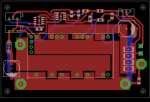Thanks Charles 
Current control on these things seem more handy than voltage. I haven't actually powered mine up yet, but from what I read in the datasheet, I thought the track pin was only active during power up/down, kind of cool that it stays active the whole time.
Current control on these things seem more handy than voltage. I haven't actually powered mine up yet, but from what I read in the datasheet, I thought the track pin was only active during power up/down, kind of cool that it stays active the whole time.
Last edited:









